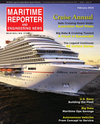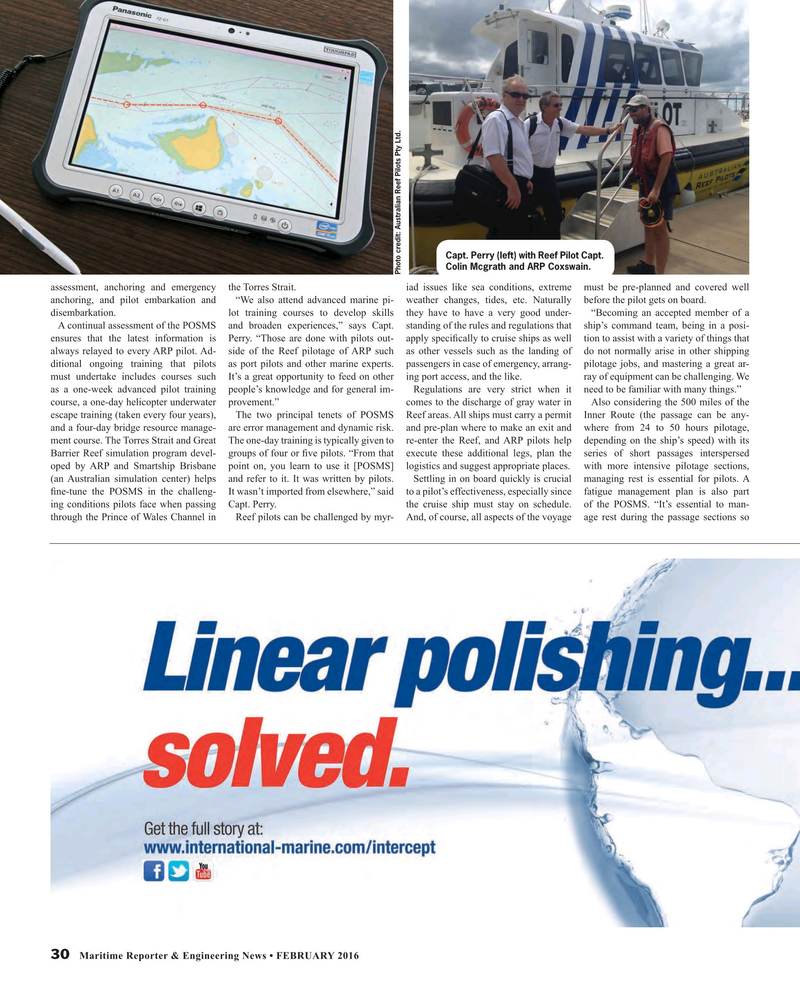
Page 30: of Maritime Reporter Magazine (February 2016)
Cruise Ship Technology Edition
Read this page in Pdf, Flash or Html5 edition of February 2016 Maritime Reporter Magazine
Capt. Perry (left) with Reef Pilot Capt.
Colin Mcgrath and ARP Coxswain.
Photo credit: Australian Reef Pilots Pty Ltd.
assessment, anchoring and emergency the Torres Strait. iad issues like sea conditions, extreme must be pre-planned and covered well anchoring, and pilot embarkation and “We also attend advanced marine pi- weather changes, tides, etc. Naturally before the pilot gets on board. disembarkation. lot training courses to develop skills they have to have a very good under- “Becoming an accepted member of a
A continual assessment of the POSMS and broaden experiences,” says Capt. standing of the rules and regulations that ship’s command team, being in a posi- ensures that the latest information is Perry. “Those are done with pilots out- apply speci? cally to cruise ships as well tion to assist with a variety of things that always relayed to every ARP pilot. Ad- side of the Reef pilotage of ARP such as other vessels such as the landing of do not normally arise in other shipping ditional ongoing training that pilots as port pilots and other marine experts. passengers in case of emergency, arrang- pilotage jobs, and mastering a great ar- must undertake includes courses such It’s a great opportunity to feed on other ing port access, and the like. ray of equipment can be challenging. We as a one-week advanced pilot training people’s knowledge and for general im- Regulations are very strict when it need to be familiar with many things.” course, a one-day helicopter underwater provement.” comes to the discharge of gray water in Also considering the 500 miles of the escape training (taken every four years), The two principal tenets of POSMS Reef areas. All ships must carry a permit Inner Route (the passage can be any- and a four-day bridge resource manage- are error management and dynamic risk. and pre-plan where to make an exit and where from 24 to 50 hours pilotage, ment course. The Torres Strait and Great The one-day training is typically given to re-enter the Reef, and ARP pilots help depending on the ship’s speed) with its
Barrier Reef simulation program devel- groups of four or ? ve pilots. “From that execute these additional legs, plan the series of short passages interspersed oped by ARP and Smartship Brisbane point on, you learn to use it [POSMS] logistics and suggest appropriate places. with more intensive pilotage sections, (an Australian simulation center) helps and refer to it. It was written by pilots. Settling in on board quickly is crucial managing rest is essential for pilots. A ? ne-tune the POSMS in the challeng- It wasn’t imported from elsewhere,” said to a pilot’s effectiveness, especially since fatigue management plan is also part ing conditions pilots face when passing Capt. Perry. the cruise ship must stay on schedule. of the POSMS. “It’s essential to man- through the Prince of Wales Channel in Reef pilots can be challenged by myr- And, of course, all aspects of the voyage age rest during the passage sections so 30 Maritime Reporter & Engineering News • FEBRUARY 2016
MR #2 (26-33).indd 30 2/3/2016 10:41:44 AM

 29
29

 31
31
